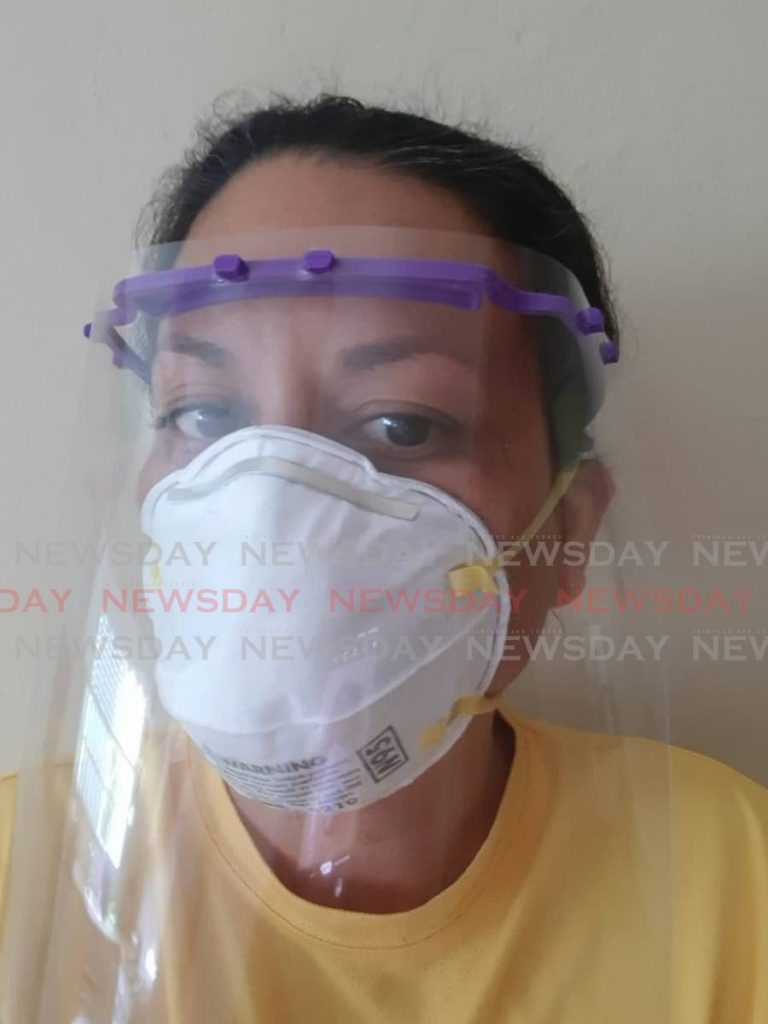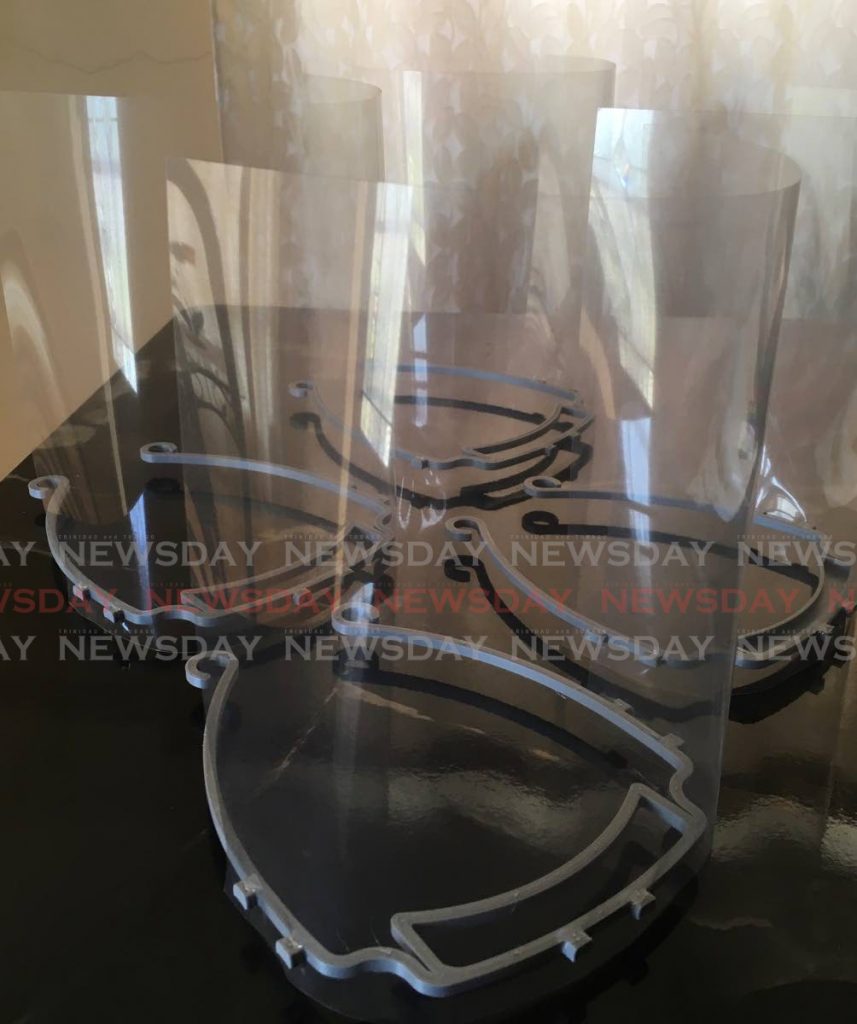Engineer supplies free face shields to frontline workers

Shivanand Chanderbally and four others are working their 3D printers around the clock to meet requests for face shields which offer more protection for front line workers, particularly those at hospitals and health centres.
The opaque, plastic shields are worn alongside the standard N95 face masks.
They are being worn globally, by medical staff in countries most hard hit by covid19.
Chanderbally, 42, who holds a BSc in Electrical and Computer Engineering and an MBA in Strategic Planning, first posted his intentions to provide medical staff with the shields on social media.
"We were really surprised at the number of requests that have come, not only from medical professionals but from all areas of society. While the masks are effective, I don't believe that the public needs to wear face shields when they go out as long as they practice recommended safe social distancing.
"Face shields are really intended for persons who are in close contact with individuals, who may potentially be infected and prevents large droplets from coming in contact with their face should the infected individual cough or sneeze."
Chanderbally, a father of three, also made an appeal for other like-minded enthusiasts to join the cause.
That call was answered by fellow 3D printers, Monique Walker, Terrence John on behalf of Presentation College, San Fernando, Amjad Ali and one other printer who requested anonymity.
Chanderbally said, "I first started thinking about printing face shields around mid February, but since Trinidad didn't yet have any covid19 cases, I didn't actually start printing them until after the first case was announced on March 12."
To date, Chanderbally, a project manager in the oil and gas industry, said he has printed over 100 masks. So far the group has printed over 300 shields and anticipates that by mid week that figure will double.
The request list, he added, is quite long and increases daily.
When government announced advice from The Centers for Disease Control and Prevention (CDC) that people in countries affected by the virus wear cloth face masks, a rush of suppliers popped up on social media.
The prices ranged from as low as US$10 to as high as S$75.
In fact a directory of suppliers, their contact information and their districts, was posted online.
"I think it's great that more and more persons are becoming aware and as long as they take the necessary precautions, the interaction to collect a mask (cloth) should be short and swift," he advised.
Chanderbally, however, said they opted to offer the shields for "free because they are appreciative of the risk that healthcare workers face daily, as they fight to save the infected and curb the spread of covid19."
Technically, he said, the shields are not free but the printers are prepared to absorb the costs.
"There are costs to the material, power and time put into getting them printed. This cost is absorbed by the enthusiast as goodwill and the masks provided free to the medical professionals who are in dire need of PPE."
The average cost to manufacture the shields ranges between $5 to $8, depending on the type of material being used, said Chanderbally.
He recalled having to refine initial shields, as it took upwards of one and half hours to produce. Those, he added, had been larger and more durable.
"Over the weeks, the designs have been iterated with once particular design gaining favour among enthusiasts. The design we are printing takes approximately 40 minutes when printed in bulk. If they are printed by themselves they can take anywhere from 45 minutes to one and quarter hours per mask."

Even with certain restrictions in place, such as closure of businesses other than government's published list of essential services, Chanderbally said material has not been hard to source.
Most of the materials used to print the shields, are sourced online, through Amazon, but can be bought from manufacturers of the plastic filament needed.
"A typical roll of filament if shipped with a local freight forwarding company can cost as little as TT$300 all the way up to more than one thousand dollars for really exotic filaments. The clear sheet that mounts on the face shield frame is sourced locally from any reputable stationery store.
Chanderbally, though, didn't just decide to offer his services on a whim, he did extensive research into the product and its effectiveness.
"Face shields cover more of the face than masks and prevent the wearer from touching their face. Importantly, face shields are durable, can be cleaned after use, reused repeatedly, and for many people are more comfortable than face masks.
"That being said, it is highly recommended that face masks be used in conjunction with face shields."
One medical expert in Washington was reported to have told CNN, "If you have an N95 mask and you don't have a face shield, you don't have any protection."
As for distribution, Chanderbally said his small group shared a list of people and facilities who have requested face shields and their quantities. The group communicate daily on production, designs, information that may enable easier, faster manufacturing and uniformed distribution.
At this stage, Chanderbally said, he firmly believes the shields are best suited for people who are in close contact with those potentially infected or confirmed infected.
"The World Health Organization (WHO) has produced technical specifications for face masks, based on simulation exercises using data from past SARS and MERS outbreaks. In as much as there are currently no standards for face/eye protection against biological hazards, and research data is scant, recommendations for the proper selection of face shields for infection control must rely on currently available knowledge, the task to be performed and the anticipated risk associated with the procedure," said Chanderbally.
Shields have since been distributed to personnel at the accident and emergency departments at the San Fernando General Hospital, the Chaguanas Health Centre, the San Fernando West Regional Health Authority, the North West Regional Health Authority and the paediatric emergency department at Eric Williams Medical Sciences Complex, Mt Hope.
Chanderbally, said while he believes the use of cloth face masks should have been implemented earlier, he is mindful that it was only recently (April 3) the CDC changed their recommendation to wear masks in public.
Chanderbally has been doing 3D printing for the last three years. It started off as a hobby, but has since grown from one printer to three, one of which he built from scratch assembling parts from China, the US, UK and Germany.
Chanderbally said, while a hobby is an admirable pastime, he thinks when one can use it to "give back" to society, it becomes even more fulfilling.
In fact, each year he auctions prints made from his 3D printers and donates the proceeds to various charities.
In the meantime, Chanderbally said he intends to continue to print and supply as the need arises, heed the abundance of good information and recommendations by the authorities and work his regular job from the safety of his home in central Trinidad.

Comments
"Engineer supplies free face shields to frontline workers"